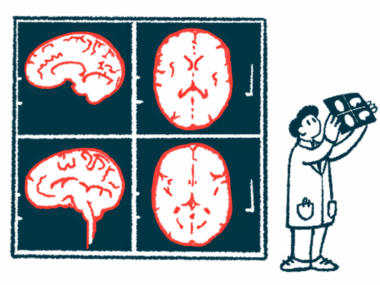Stem cell therapy leads to short-term disability reduction in MS
But no differences seen by 1-year mark vs. control patients, analysis finds
Written by |

People with multiple sclerosis (MS) tend to experience a short-term reduction in disability and brain lesion volume after receiving stem cell therapy, according to a meta-analysis of nine studies detailing randomized clinical trials.
After six and 12 months, however, the researchers found no differences in disability between patients who underwent stem cell therapy and controls, or individuals with MS who received another treatment or a placebo. Moreover, the use of the stem cell therapies did not significantly improve measures of motor function, hand dexterity, and cognitive function among patients.
Clinical improvements occurred primarily among individuals who received their own hematopoietic stem cells (HSCs), or stem cells that give rise to blood cells, and were less evident in a group that received another type of stem cells called mesenchymal stem cells (MSCs).
The scientists said more studies of stem cell therapy in MS were needed, noting that “longer follow-up of [randomized controlled trials] will help to detect the long-term effect on disease progression and determine long-term safety concerns.
“We also encourage [clinical trials] to compare different routes of [stem cell therapy] … to determine the administration route that yields optimal results,” the team added.
Their findings were detailed in “Efficacy and safety of stem cell transplantation for multiple sclerosis: a systematic review and meta-analysis of randomized controlled trials,” published in the journal Nature Scientific Reports.
Many variations seen in trials testing stem cell therapy in MS
In MS, the immune system mistakenly attacks the fatty protective layer around nerve fibers, called the myelin sheath. Because myelin helps speed electrical signals, its loss leads to deficits in neuronal communication and a range of MS symptoms.
A stem cell transplant represents a potential way to reset the faulty immune response and stop these misguided inflammatory attacks. It typically involves partly or fully wiping out a patient’s immune system with a course of chemotherapy or radiation therapy — a preparatory treatment known as immunosuppression — and then replacing it with HSCs that can grow into healthy immune cells.
In addition to HSCs, mesenchymal stem cells, which can develop into bone, cartilage, and fat cells, are also commonly used in MS therapy. However, these cells are mainly designed to produce signaling molecules that boost neuronal survival and do not require immunosuppression to work.
In clinical trials, stem cell therapy has generated promising results in clinical and quality-of-life improvements in MS patients. Still, these studies followed different protocols regarding dosage, the origin of stem cells, and the route of administration.
“These variations limited finding the transplantation approach that produces the optimal benefits for MS patients,” the researchers wrote.
When faced with varying findings in the medical literature, scientists can conduct a meta-analysis, which pools data from multiple studies that address a similar research question. Such analyses can find patterns or trends, help clarify conflicting findings, and summarize current research to guide future studies.
In this report, a team of researchers in Egypt conducted a meta-analysis to assess the efficacy and safety of various stem cell transplant approaches in MS. The team pooled data from nine randomized controlled trials that enrolled a total of 422 MS patients.
Two studies applied immunosuppression before autologous HSCs, using the patient’s own stem cells, while seven studies transplanted MSCs without immunosuppression. All studies infused stem cells intravenously, or directly into the bloodstream, except one study, which included an injection into the spinal canal.
More studies needed to determine long-term effects, scientists say
The results from all the studies, regardless of stem cell origin, showed that patients who received a stem cell transplant experienced a reduction in their disability after two months. Disability was measured with the commonly used Expanded Disability Status Scale (EDSS).
However, no significant differences between stem cell therapy and control patients were observed at the last reported follow-up for most studies.
Only one study showed that patients who received autologous HSCs plus immunosuppression experienced a significant EDSS reduction at one year. Meanwhile, those treated with MSCs without immunosuppression showed nonsignificant improvement over controls at six months.
EDSS scores before transplants, stem cell doses, and stem cell sources (adult or embryonic) did not appear to influence EDSS outcomes. There were no differences in the number of relapses between the treatment and control groups.
In other outcome measures, stem cell therapy resulted in non-significant improvements in motor function, finger dexterity, and cognitive function. However, when only patients who received HSCs were included, there were significant improvements in motor function and finger dexterity compared with controls.
MRI studies revealed a significant reduction in the volume of brain lesions, or signs of myelin damage, but not in the number of lesions.
This meta-analysis showed that [stem cell transplant] improves multiple sclerosis patients’ disability at 2 months and reduces their brain lesions volume. … However, we cannot generalize our results due to the sparse number of [randomized clinical trials].
Across most adverse events, the difference between transplants and controls was nonsignificant. Administration-related side effects, including infusion site swelling, bruising, and pain, were significantly more common in the transplant group compared with the control group. Autologous HSCs were significantly associated with a higher incidence of blood and lymphatic system-related side effects, the analysis found.
“This meta-analysis showed that [stem cell transplant] improves multiple sclerosis patients’ disability at 2 months and reduces their brain lesions volume,” the researchers concluded.
“However, we cannot generalize our results due to the sparse number of [randomized clinical trials] assessing [autologous HSC transplant] combined with immunosuppression for MS,” they added.






